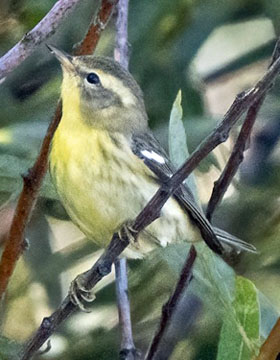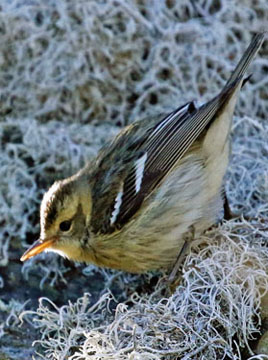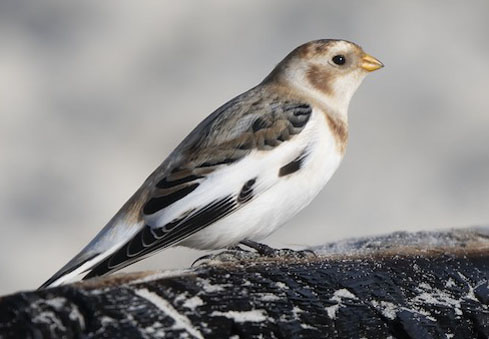These highlights chronicle the year 2022. While most of my highlight pages run
"backwards"— with updates made during a season, and more recent ones updates posted at the top — this update page has been so long delayed that it runs from late September directly through to year's end. On this particular page, note that I have previously featured non-passerine highlights for September 2022 on the "summer" page to provide more room for landbird highlights in September 2022 on this page.
In crediting records of vagrant or unusual birds, I try to credit the finder(s) but there will be times when the answer is "its complicated." At times one or more observers find the bird but others are the ones to identify it. There will be times when proper identification occurs days later after expert photo review. In other cases, a finder may not post the finding to local 'rare bird hot-lines' or Internet posting groups, and someone else will 'find' the same bird (without prior knowledge it was there). In those cases I'll prefer to give credit to those who share their rarity finds in a timely manner.
The abbreviation "MTY" means "Monterey County"
in the text below; "m.ob" means "many observers" and "v.ob" means "various observers." Text by Don Roberson. Photos on this page
are copyrighted by the photographers to whom they are
attributed, and may not be reproduced in any form (including
other web sites) without the express consent of the photographer. |
| |
 The final week of September produced an excellent vagrant for fall migration: a Kentucky Warbler at Frog Pond Nature Preserve, Del Rey Oaks, on 28 Sep by Brian Sullivan & Paul Fenwick (photo left, 29 Sep © Bill Hill). This is only the third ever for fall migration in MTY, and just the 7th overall for the county (3 spring migrants in May-June, 1 winter bird in January). The prior fall vagrants visited the birdbath at the home of Alan & Sheila Baldridge irregularly from 21-29 Oct 1990, and another birdbath in Pebble Beach on 7 Sep 2017. That latter bird, plus another caught at Big Sur Ornithology Lab at Andrew Molera SP on 18 May 2004 (Rob Fowler), are the only ones for this century.. The final week of September produced an excellent vagrant for fall migration: a Kentucky Warbler at Frog Pond Nature Preserve, Del Rey Oaks, on 28 Sep by Brian Sullivan & Paul Fenwick (photo left, 29 Sep © Bill Hill). This is only the third ever for fall migration in MTY, and just the 7th overall for the county (3 spring migrants in May-June, 1 winter bird in January). The prior fall vagrants visited the birdbath at the home of Alan & Sheila Baldridge irregularly from 21-29 Oct 1990, and another birdbath in Pebble Beach on 7 Sep 2017. That latter bird, plus another caught at Big Sur Ornithology Lab at Andrew Molera SP on 18 May 2004 (Rob Fowler), are the only ones for this century..
Although this year's Kentucky Warbler was a skulker as expected, walking on the heavily wooded floor of the Frog Pond Preserve and often hidden from sight in the undergrowth, many birders were able to enjoy seeing it because it gave loud 'chip' notes fairly often and quiet patience was rewarded. It stayed at least 6 days, through 3 October.
|
| Earlier that same week, Michael Rieser found two other impressive warblers: a Mourning Warbler at Monastery Beach on 23 Sep (below left, © Michael Rieser), and a Virginia's Warbler — a vagrant from the southwest or northern Mexico — at Carmel River State Beach on 26 Sep (below right, © Michael Rieser). The latter stayed long enough for others to see it on 27 Sep. Mourning Warbler is another rare skulker; this was the 16th MTY record. |
|
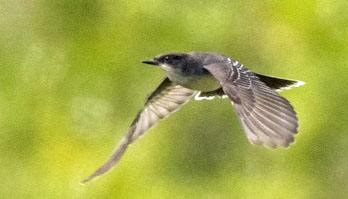 Other September vagrant passerines included Eastern Kingbirds: one at Moonglow Dairy 12-15 Sep (Cooper Scollan et al.), and one in the restricted-access Odello area at Carmel R. mouth from 16-22 Sep (Karen Kreiger et al., photo right 16 Sep, © Karen Kreiger). Single Least Flycatchers were photographed at Moss Landing on 23 Sep (Kent Van Vuren) and at Carmel R. mouth on 24 Sep (Paul Fenwick, Brian Sullivan, Rita Carratello, Don Roberson). Other September vagrant passerines included Eastern Kingbirds: one at Moonglow Dairy 12-15 Sep (Cooper Scollan et al.), and one in the restricted-access Odello area at Carmel R. mouth from 16-22 Sep (Karen Kreiger et al., photo right 16 Sep, © Karen Kreiger). Single Least Flycatchers were photographed at Moss Landing on 23 Sep (Kent Van Vuren) and at Carmel R. mouth on 24 Sep (Paul Fenwick, Brian Sullivan, Rita Carratello, Don Roberson).
On 30 September, Brian Sullivan undertook a 4.5 hour hawkwatch from the very top of Fremont Peak, on the Monterey/San Benito county line, overlooking the lower Salinas Valley. He tallied 62 raptors (hawks & falcons) of 10 species, including single Broad-winged and Swainson's Hawk, considered rarities in MTY. This hawkwatch, and another in early October, also tallied fine passerines, including Evening Grosbeak and a Cassin's Finch. |
September was a fine start of autumn migration, but October would bring a cornucopia of avian riches — both in terms of passerine diversity and in terms of numbers of vagrants — that some old-timers compared to the "glory years" of the 1970s, some of the 1980s, and 1993, 1996 & 1998.
| The first of October 2022 was a Saturday. The stake-out but skulky Kentucky Warbler was still at the Frog Pond Preserve. It was Mark Kudrav's day to shine — finding "mega" rarities both early and late that day. The morning discovery was in the "thicket" at Pacific Grove's El Carmelo Cemetery: a bright, glowing Prothonotary Warbler (photo below left from 2 Oct, © D. Roberson). Then, late in the afternoon, Mark decided to check Del Rey Park — across the road from the now-heavily-birded Frog Pond — and he came upon a Great Crested Flycatcher (photo below right 1 Oct, © D. Roberson). Both rarities would appear and then disappear, but over time many observers had satisfying views. The Great Crested even caught a Blue-eyed Darner, but then found it took a long time to swallow a large dragonfly (see photo)! |
|
Previously, there had been 23 records for Prothonotary in MTY — including spring, summer, and winter observations but the majority in autumn — so this was the 24th [and a 25th was a one-day-wonder at Moonglow Dairy on 15 Oct (Kent Van Vuren)].
For Great Crested, there were nine prior MTY records, all in fall migration. Discovered by Kudrav on the same day, these two vagrants would follow dramatically different trajectories. The Great Crested Flycatcher was gone the next morning, but the Pacific Grove Prothonotary would stay through 15 October. Its beauty and occasional elusiveness entertained dozens — many even a hundred? — observers over its two-week stay. Although sometimes seen bathing in a mud-puddle on the adjacent Pacific Grove golf course, or seen sitting on a tee-box, it spent much of its time deep inside the "thicket." Birders searching for it from 1-15 October also found other rarities: Plumbeous Vireo, American Redstart, Tennessee & Magnolia & Blackpoll Warblers, and Carole Rose photographed a half-minute Scarlet Tanager on 4 October.
While the Great Crested had a meal and moved on, the Prothonotary was a headliner for half of October. |
|
P.G.'s Prothonotary had been held over for its second week when Bill Hubick introduced the two next show-stoppers. He did this, at least initially, by taking his family to explore the local tidepools at John Denver Memorial beach, on the Bay side of Pt. Pinos, where there is sand and lots of squishy non-native ice-plant. Bill writes: "While packing up the car and with no binoculars or camera in hand, I spotted an intriguing bird hopping around in the ice-plant. My wife Becky saw the look on my face (as Tennessee Warbler and others were ruled out) and offered to run and grab my camera from the car." Yet, oblivious to the fact that ice-plant is never used by hungry migrants, was a fresh young Yellow-green Vireo! (below left, 8 Oct, © Bill Hubick). The ice-plant-walking vireo remained for four days, ignoring hordes of beach-loving tourists, and permitted itself to be photographed many times in this supposedly unsuitable habitat. |
|
So about ten days go by. By 19 Oct both the glowing Prothonotary and the naive Yellow-green have continued on. Bill Hubick was back to birding parks and cemeteries, with camera in hand. On this particular day, Bill was at one of the El Estero cemeteries in Monterey, but we'll let him tell the story (to quote his eBird account): "On this warm and sunny afternoon, many migrants were feeling the heat, standing in the shade with bills open. I thought, wow, that Palm Warbler looks weird and hot, almost like a vireo. Wouldn't it be funny if it was a vireo on the lawn? Maybe it's a Yellow-green Vireo... Oh god, it is!" (photo above right, 19 Oct, © Bill Hubick). And so here we have a Neotropical vireo foraging on the grass. What ever became of trees or vine-tangles or shady canopies? This silly bird was also photographed by "millions of birders" (caution: hyperbole).
In fact, in an ironic and funny back-story, I (Don Roberson) ran into some comparative new birders at Monterey cemetery after hearing about Bill's second Yellow-green Vireo. One of them told me he'd photographed a “Red-eyed Vireo” at that spot the previous day. When he forwarded his photo to me at my request, it was clear that he had actually photographed this Yellow-green Vireo on 18 Oct (and yet another photographer on 18 Oct had made the same mistake). It turned out that the full dates for the Monterey cemetery Yellow-green Vireo were 18-23 October. [There were also two actual Red-eyed Vireos in MTY in fall 2022 ... and with photos.]
There were previously 17 records of this vireo for MTY — including an incredible four of them in fall 2021 — so these two in 2011 bring the county total to 19 Yellow-green Vireos. |
|
In MTY, the rarest and most sought after North American warblers [Family Parulidae] are Blue-winged & Golden-winged plus Connecticut (from the northeast); Worm-eating & Cerulean & Pine plus Louisiana Waterthrush (from the southeast); and Grace's & Red-faced plus Painted Redstart (from the southwest). All have occurred here except Red-faced (Red-faced has appeared on SE Farallon I. and in Alameda Co. (A Golden-cheeked Warbler on SE Farallon in 1971 is usually considered next-to-impossible to occur again). In MTY, of our "top ten" most prized potential parulids, all have occurred more than once except Golden-winged and Painted Redstart and Pine — at least until October 2022. The single Pine Warbler had been a one-day-wonder photo'd and documented in the huge single cypress above the Big Sur R. mouth back on 24 Oct 1993 (Bob Maurer & Bob Tintle). Then, remarkably, in the span of just 9 days in 2022, two different Pine Warblers were discovered!
The first Pine Warbler of 2022 was found by Brian Sullivan on 25 Oct in a pine tree at San Carlos Cemetery, one of several cemeteries adjacent to El Estero lagoon in the City of Monterey (photo below left, 25 Oct © Brian L. Sullivan). Brian wrote (in eBird) that it was "foraging mostly in pines on the east side of the cemetery. Only briefly visiting the ground, and very loosely associating with other warblers." This Pine Warbler stayed 3 days, giving almost every local birder the opportunity to add this to their county list. |
|
| The second Pine Warbler of 2022 was discovered at Pacific Grove's El Carmelo Cemetery on 2 Nov by Carole & Larry Rose (photo above right, © Carole Rose. Carole wrote (in eBird) that "Larry spotted this rarity foraging on the ground and sometimes seeking safety in the cypress. This was in the corner of the old cemetery closest to the cannon/flagpole. As you can see it was quite cooperative as I stood still and it foraged closer and closer to me." As shown in the photo (above right) it foraged on the edges of graves and tombstones as well as on the ground and a cypress. This Pine Warbler, though, was only present for a few hours on 2 November. [Yet another Pine Warbler was in Watsonville, Santa Cruz Co., very close to MTY, on 14 Oct. Together with the two in MTY, these seem likely to have arrived due to either a bumper-crop of young Pines this year in the East, or due to some weather pattern that affected them all.] |
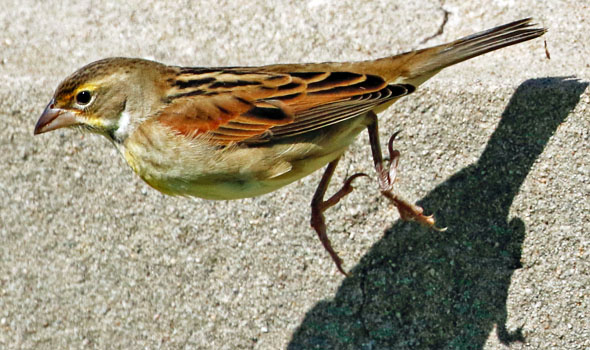 During the week preceding Sullivan's piney find, El Estero cemeteries in Monterey were often tramped by birders, with more routine rarities seemingly found day after day. The eBird alert of a Clay-colored Sparrow caught the attention of a birder passing by, who stopped by to seek a county bird. What Gary Deghi found instead was an engaging hatch-year Dickcissel (photo right 13 Oct, © D. Roberson). It would remain in the same general area of grass and cement edgings for 11 days — from 13-23 October — and attract observers with cameras from far and near. During the week preceding Sullivan's piney find, El Estero cemeteries in Monterey were often tramped by birders, with more routine rarities seemingly found day after day. The eBird alert of a Clay-colored Sparrow caught the attention of a birder passing by, who stopped by to seek a county bird. What Gary Deghi found instead was an engaging hatch-year Dickcissel (photo right 13 Oct, © D. Roberson). It would remain in the same general area of grass and cement edgings for 11 days — from 13-23 October — and attract observers with cameras from far and near.
Dickcissel is not an annual visitor, but records have included individuals at feeders, or fly-overs identified by call — like another one at Carmel on 29 Oct (B.L. Sullivan, P. Fenwick). Brian & Paul discovered a Lucy's Warbler nearby that day that lingered to 31 October. |

On the last day that the Monterey cemetery Pine Warbler was present (27 Oct), Brian Sullivan and Richard Crossley discovered a hatch-year Bay-breasted Warbler at Laguna Grande. There had been only 9 previous records for MTY, so it, too, was startling. Yet two more Bay-breasts would be discovered in the following two weeks: the second one at Berwick Park in Pacific Grove on 4 Nov, found by Bill Hubick during a long run on the coastal rec trail (!) and the third at Carmel River mouth on 13 Nov (Michael Rieser). All were photographed, but only the Berwick Park individual lingered for photo opportunities by dozens and dozens of birders between 4–6 Nov. Like the remarkable Yellow-green Vireos this fall, and both of the Pine Warblers, this vagrant spent a lot of time foraging on manicured grass in parks (here) or cemeteries. I like this shot with its unique perspective of a crisp autumn Bay-breasted Warbler (photo left 4 Nov, © Cooper Scollan).
These 3 Bay-breasted Warblers, breaking the prior high count of two in one autumn (2018), bring the MTY county total 12 records.
|
|
There was such a diversity in passerines this fall — from a White-winged Dove at Laguna Grande 12-15 Sep (Gary Dial, Bill Hubick) to a Townsend's Solitaire in the Pacific Grove cemetery on 3-4 Nov (Rachel Lawrence, Mark Chappell, m.ob.) — that 9 local birders recorded 300 or more species on the MTY "year list" for 2022. Yet it was, I think, an autumn dominated by warblers. Some 30 species of Parulidae were documented in MTY in fall 2022: ten "regular" western migrants and 20 vagrants from the east or southwest. We missed species like Ovenbird or Black-throated Blue (and other rarer ones), but there was a single Black-throated Green Warbler from 23-25 Oct in a Monterey cemetery (D.J. Singh, B.L. Sullivan).
Before we get into some analytics about warblers this fall, I want to highlight a couple of examples of quite late eastern warblers. On 8 Nov, at John Denver Memorial beach — the same spot Bill Hubick found a Yellow-green Vireo in the ice-plant — visiting birder Joshua French was shocked to find a Canada Warbler (photo below left, © Joshua French). He wrote: "Huge surprise! Lifer. First seen on the ground amongst the shrubbery ... (but then) moved out to the beach ... until dark. Mostly foraged at strand-line among seaweed/kelp, sand, and rocks ... Hunkered behind kelp during downpour." What a cool experience for one's lifer!
In a year that had two other Canada Warblers: 21 Sep near Yankee Pt. (B.L. Sullivan); 12-13 Oct near Asilomar SB (Terence Degan; v.ob.)] — tying the fall migration record for MTY — a November stray foraging a storm-washed kelp was a complete surprise. The only prior Canadas that were later in fall were 9-12 Nov 1993 Carmel R. mouth (Bob Maurer, Rita Carratello) and 13 Nov 2020 Locke-Paddon Park, Marina (Kent Van Vuren; m.ob.). |
|
| The other warbler than tied its record for most occurrence in fall migration (6) was Blackburnian Warbler (above center & right). The hatch-year Blackburnian next to In-n-Out Burger at Laguna Grande Park, Seaside (photo above center 18 Oct, © Bill Hill) was found on 23 Oct by visiting birders Glenn Walbeck & Loch Kirkpatrick. What made this individual unusual is that it remained for 24 days in more or less the same willow, making it perhaps the "most easily chased" Blackburnian ever in MTY. The other hatch-year Blackburnian, found by Karen Kreiger & Rita Carratello (photo above right, © D. Roberson) had an exceedingly short stay (15 minutes) in the wispy gray Lace Lichen Ramalina menziesii on cypresses at the tip of Pt. Lobos before flying off towards Pebble Beach, but the date was 7 December! Two prior November Blackburnians had lingered into Dec (1985, 1999) but the other Blackburnian discovered in December wintered in Pacific Grove from 29 Dec 1986–22 Mar 1987 (D. Roberson). So December records are rare indeed. |
|
| |
The table below compares how fall migration in 2022 — September into early December 2023 — to Monterey County's "average" numbers of "vagrant eastern warblers" from prior autumn occurrences. The book Monterey Birds, 2d ed (Roberson 2002) summarized the status and distribution of rare eastern warbler through 2001. In the table, the "top dozen" most regular "rare eastern warblers" are ranked by their averages as published in Monterey Birds. Those averages for fall migration are then compared to data from the last then years (2012-2021). Another column sets out highest historic total in any fall migration. The final two columns set out how many were tallied in fall 2022, and provides a brief comment.
You'll note that there have been changes in rankings this century. While previously Chestnut-sided Warbler averaged about 6 per fall last century, its recent average is 9.1/fall, and it has become the third-most-common 'eastern' warbler locally. This fall was even stranger. The most common 'eastern' warblers in Sep-Oct were Tennessee (33), Black-and-white (13), and Chestnut-sided (11); most of the 23 Palm Warblers appeared in late October through November. Much less common species — Magnolia, Blackburnian, and Canada — had or tied their best fall ever here in MTY. The even-rarer species — Bay-breasted and Pine — had their best fall ever.
[Not included in the table are the southwestern Virginia's & Lucy's Warblers. They have averaged about 0.5/year — one every other year — pretty much steadily for 5 decades. We had one of each this fall.] |
|
| 'Eastern' Warblers |
"Mty Birds" avg/fall |
Last 10 yrs avg/fall |
Highest total/fall |
Total fall 2022 |
Comments |
| Palm |
~30 |
18.8 |
122 in 1993 |
23 |
below avg |
Blackpoll |
16 |
9.1 |
56 in 1998 |
10 |
about avg |
| Black-and-white |
9 |
5.7 |
16 in 1993 |
13 |
above avg |
| Amer. Redstart |
7 |
5.3 |
17 in 1994 |
9 |
above avg |
| No. Waterthrush |
6 |
5.8 |
17 in 1998 |
8 |
above avg |
| Chestnut-sided |
6 |
7.8 |
17 in 2018 |
11 |
above avg |
| Tennessee |
5 |
4.5 |
13 in 2017 |
33 |
best fall ever by far |
| Magnolia |
4 |
1.6 |
8 in 1998 |
6 |
well above avg |
| Prairie |
3 |
0.7 |
7 in 1998 |
1 |
about avg |
| Northern Parula |
2 |
1.6 |
3 in 2020 |
4 |
about avg |
| Blackburnian |
~0.5 |
2.7 |
6 in 2018 & 2020 |
6 |
ties best fall ever |
| Canada |
~0.5 |
0.6 |
3 in 2018 |
3 |
ties best fall ever |
| and turning to some selected rarer eastern warblers |
| Warbler species |
"Mty Birds" total recs |
Last 10 yrs avg/fall |
Highest total/fall |
Total fall 2022 |
Comments |
| Bay-breasted |
only 5 recs total |
0.4 |
2 in 2019 |
3 |
best fall ever |
| Prothonotary |
16 recs, 11 in fall |
0.2 |
2 in '91, '97, '98 |
2 |
tied best fall |
| Mourning |
11 recs, 10 in fall |
0.2 |
2 in '96 & '99 |
1 |
any one is nice |
| Kentucky |
3 recs, 1 in fall |
0.1 |
1 in 1990 & 2007 |
1 |
just 3d fall rec |
| Pine |
1 rec in fall 1993 |
<0.1 |
1 in any fall |
2 |
best fall ever |
|
| |
MONTEREY AUDUBON SEAWATCH at Pt. Pinos 1 Nov–15 Dec 2022

Monterey Audubon's seventh annual seawatch from Pt. Pinos featured expert Michigan seawatcher Alison Vilag. From dawn to dusk, 6 days a week for six weeks, she tallied migrant seabirds in every kind of weather. Sunny, calm days can be slow, but breezy or stormy days can bring too many birds to count. Her tallies of primary interest migrants included over 97,000 Pacific Loon & over 53,000 Surf Scoters. Rare waterfowl included 30 Black Scoter (one female with Surf Scoters below, © Blake Matheson) and 5 Long-tailed Ducks.

Alison also documented some remarkable landbird vagrants from Pt. Pinos during her six weeks, including
a Lesser Nighthawk on 8 Nov, Short-eared Owl on 9 Nov, White-winged Dove on 25 Nov, and a Lapland Longspur that landed on the shore on 3 Nov (photo below, © Blake Matheson). She saw a Brown Booby fly past on 1 Dec.
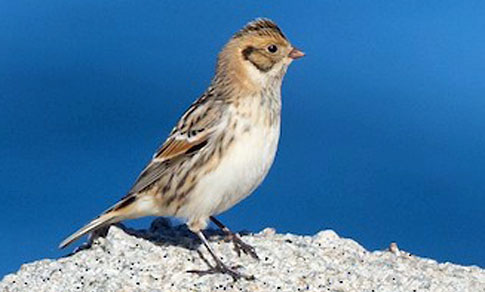
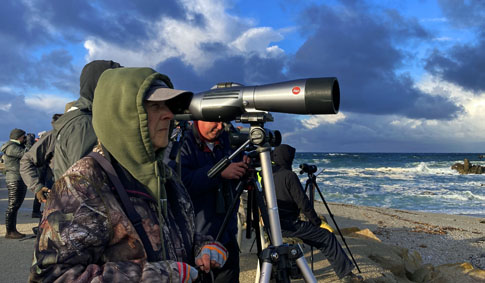
Local birders joined Alison most days during the formal seawatch, or were drawn to Pt. Pinos when windy conditions provided opportunities for rare seabirds. This photo (above) is from 2 Nov, when a Laysan Albatross was seen by many. In Dec, Alison and others watched Leach's & Fork-tailed Storm-petrels. Prior to the seawatch, on 22 Oct, Brian Sullivan and others saw another Laysan, a Flesh-footed and a Manx Shearwater, up to 9 Tufted Puffins, and a passing Yellow-billed Loon (first spotted by Carole Rose).
|
SIDEBAR: California's amazing autumn for Old World passerines
While Monterey County (MTY) had a wonderful autumn migration of vagrant Parulid warblers and other passerines from the east or southwest, two astonishing "Old World Warblers," in family Phylloscopidae, occurred in October: one south of MTY and the other north of us. Previously, the State had multiple records of Dusky Warbler Phylloscopus fuscatus and a few of Arctic Warbler P. borealis [incl. records of each in MTY], plus one Yellow-browed Warbler P. inornatus. These three Phylloscopus breed into Siberia, and were 'wrong-way' vagrants that reached western North America. Although they are "mega-rarities" in the lower 48 United States, their range and long-distance migration routes, which had brought prior records to Alaska, made them almost predictable.
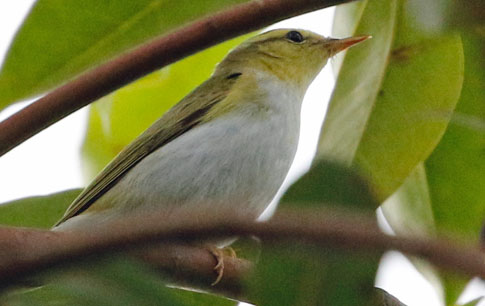
Wood Warbler in Long Beach, Los Angeles Co. (photo above, D. Roberson)
Willow Warbler at Rodeo Lagoon, Marin Co. (photo below, D. Roberson)
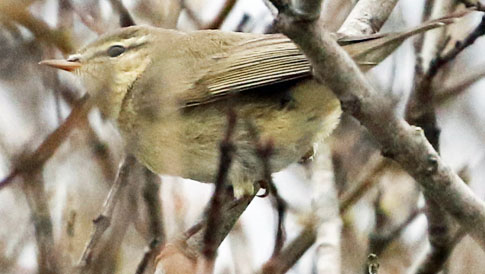
A Wood Warbler in Los Angeles Co., and a Willow Warbler in Marin Co., were not among the Old World passerines must of us thought would occur in California. Their ranges in eastern Europe and central Asia, with wintering routes mostly towards Africa, did not seem to favor vagrancy towards us. The most likely route would be over the North Pole! Yet, here they were. Each warbler stayed 6-9 days for long-distance twitchers.
Then at year's end, Matt Brady discovered a Red-flanked Bluetail Tarsiger cyanurus in Santa Cruz. This shy, skulking Old World flycatcher breeds into Siberia and winters to southeast Asia. There are now 6 State records, with 4 of them on islands (Farallones, San Clemente I.). One wintered in a formal garden in Los Angeles from 21 Dec 2018–22 Mar 2019. It was seen by many State birders but views tended to be brief.
This seems to be true of the Santa Cruz bird as well, where views and photos have been brief and difficult. Some MTY birders went up to (try to) see it; Beth Hamel managed this fine shot (below) on 30 Dec. The Bluetail is still present into mid-January and, if it survives the storms, might even winter.
Red-flanked Bluetail at Lighthouse Field SP, Santa Cruz Co. (photo below, Beth Hamel)
 |
|
| |
|
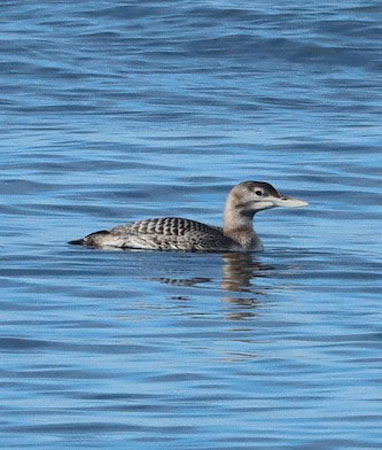 November brought a few more surprises before fall migration sputtered and ended in a series of drenching storms later in December. In the second week of November, the sandy beach portion of Asilomar State Beach, particularly at its north end in Pacific Grove, drew the birding crowds. On 10 November, George Cummins discovered a vagrant Snow Bunting on the beach (photo above left, 12 Nov © Bill Hill). Despite the tourist and dogs, the bunting remained to 15 Nov. The next day (11 Nov) Frank Fabbro and others found a wayward Nelson's Sparrow skulking in kelp and beach-debris (photo above right, 11 Nov © Carole Rose). It, too, lingered, until 16 November. A vagrant Tennessee Warbler was also in the mix on 11 Nov (Steve Tucker, Bill Hubick, v.ob.). November brought a few more surprises before fall migration sputtered and ended in a series of drenching storms later in December. In the second week of November, the sandy beach portion of Asilomar State Beach, particularly at its north end in Pacific Grove, drew the birding crowds. On 10 November, George Cummins discovered a vagrant Snow Bunting on the beach (photo above left, 12 Nov © Bill Hill). Despite the tourist and dogs, the bunting remained to 15 Nov. The next day (11 Nov) Frank Fabbro and others found a wayward Nelson's Sparrow skulking in kelp and beach-debris (photo above right, 11 Nov © Carole Rose). It, too, lingered, until 16 November. A vagrant Tennessee Warbler was also in the mix on 11 Nov (Steve Tucker, Bill Hubick, v.ob.).
With this 2022 individual, there are now five records of Snow Bunting in MTY, four of them in late fall. The first was at Pt. Lobos in Oct-Nov 1985, but 3 of the county's 5 records have been on this sandy beach at Asilomar SB: 25-26 Nov 1997, 14 Nov 2018, and now 10-15 Nov 2022. The only other Snow Bunting as at Pt. Pinos on 26 May 2009 [that bird proved to have moved north in late spring from San Diego]. I suspect more birders saw this year's Snow Bunting than saw the previous four combined. There are a tiny smattering of records of Nelson's Sparrow in MTY, going back to 1921, mostly in late fall and winter. A handful have wintered in salt marshes along Elkhorn Slough, but not recently.
Also on 12 Nov, a juv Yellow-billed Loon off the Moss Landing jetty was a one-morning wonder, spotted by Steve Tucker (photo right, © Steve Tucker). This is a species that used to be almost annual around Monterey harbor and the adjacent Bay along the Peninsula in winters in the 1970s-1980s. There were 29 records in the 20th century. Since then this is just the fifth one in 20+ years. We hypothesize that this decline could be another result of global warming. |
 Our final vagrant of 2022, excluding a few Christmas Count birds that lingered into 2023, was this fine hatch-year Harris's Sparrow at Pt. Lobos, on 6 Dec. It was discovered by long-time Pt. Lobos docent Stan Dryden (photo left, © Stan Dryden). At the time of publication of Monterey Birds, 2d ed. (2002), there were 15 MTY records, all among flocks of wintering Zonotrichia sparrows, and all but two at back-yard feeders. Since then another 8 have been found, with some, like this one, simply lost migrants. This is the 23rd county record. A fair number of local birders searched Pt. Lobos the next day, without re-locating the Harris's, but some did discover the late Blackburnian Warbler that day (see above). Our final vagrant of 2022, excluding a few Christmas Count birds that lingered into 2023, was this fine hatch-year Harris's Sparrow at Pt. Lobos, on 6 Dec. It was discovered by long-time Pt. Lobos docent Stan Dryden (photo left, © Stan Dryden). At the time of publication of Monterey Birds, 2d ed. (2002), there were 15 MTY records, all among flocks of wintering Zonotrichia sparrows, and all but two at back-yard feeders. Since then another 8 have been found, with some, like this one, simply lost migrants. This is the 23rd county record. A fair number of local birders searched Pt. Lobos the next day, without re-locating the Harris's, but some did discover the late Blackburnian Warbler that day (see above). |
| |
Literature cited:
- Roberson, D. 2002. Monterey Birds, 2d ed. Monterey Audubon Soc., Carmel, CA.
I thank Rita Carratello, Bill Hubick, and Michael Rieser for editorial comments on an earlier draft of this page.
|
|
Page created 7 Oct 2022, finished 4-20 Jan 2023
TOP
GO TO
HOME PAGE
TO MONTEREY
COUNTY
PAGE
TO BIRD
FAMILIES
OF THE WORLD
|
 November brought a few more surprises before fall migration sputtered and ended in a series of drenching storms later in December. In the second week of November, the sandy beach portion of Asilomar State Beach, particularly at its north end in Pacific Grove, drew the birding crowds. On 10 November, George Cummins discovered a vagrant Snow Bunting on the beach (photo above left, 12 Nov © Bill Hill). Despite the tourist and dogs, the bunting remained to 15 Nov. The next day (11 Nov) Frank Fabbro and others found a wayward Nelson's Sparrow skulking in kelp and beach-debris (photo above right, 11 Nov © Carole Rose). It, too, lingered, until 16 November. A vagrant Tennessee Warbler was also in the mix on 11 Nov (Steve Tucker, Bill Hubick, v.ob.).
November brought a few more surprises before fall migration sputtered and ended in a series of drenching storms later in December. In the second week of November, the sandy beach portion of Asilomar State Beach, particularly at its north end in Pacific Grove, drew the birding crowds. On 10 November, George Cummins discovered a vagrant Snow Bunting on the beach (photo above left, 12 Nov © Bill Hill). Despite the tourist and dogs, the bunting remained to 15 Nov. The next day (11 Nov) Frank Fabbro and others found a wayward Nelson's Sparrow skulking in kelp and beach-debris (photo above right, 11 Nov © Carole Rose). It, too, lingered, until 16 November. A vagrant Tennessee Warbler was also in the mix on 11 Nov (Steve Tucker, Bill Hubick, v.ob.). Our final vagrant of 2022, excluding a few Christmas Count birds that lingered into 2023, was this fine hatch-year Harris's Sparrow at Pt. Lobos, on 6 Dec. It was discovered by long-time Pt. Lobos docent Stan Dryden (photo left, © Stan Dryden). At the time of publication of Monterey Birds, 2d ed. (2002), there were 15 MTY records, all among flocks of wintering Zonotrichia sparrows, and all but two at back-yard feeders. Since then another 8 have been found, with some, like this one, simply lost migrants. This is the 23rd county record. A fair number of local birders searched Pt. Lobos the next day, without re-locating the Harris's, but some did discover the late Blackburnian Warbler that day (see above).
Our final vagrant of 2022, excluding a few Christmas Count birds that lingered into 2023, was this fine hatch-year Harris's Sparrow at Pt. Lobos, on 6 Dec. It was discovered by long-time Pt. Lobos docent Stan Dryden (photo left, © Stan Dryden). At the time of publication of Monterey Birds, 2d ed. (2002), there were 15 MTY records, all among flocks of wintering Zonotrichia sparrows, and all but two at back-yard feeders. Since then another 8 have been found, with some, like this one, simply lost migrants. This is the 23rd county record. A fair number of local birders searched Pt. Lobos the next day, without re-locating the Harris's, but some did discover the late Blackburnian Warbler that day (see above). The final week of September produced an excellent vagrant for fall migration: a Kentucky Warbler at Frog Pond Nature Preserve, Del Rey Oaks, on 28 Sep by Brian Sullivan & Paul Fenwick (photo left, 29 Sep © Bill Hill). This is only the third ever for fall migration in MTY, and just the 7th overall for the county (3 spring migrants in May-June, 1 winter bird in January). The prior fall vagrants visited the birdbath at the home of Alan & Sheila Baldridge irregularly from 21-29 Oct 1990, and another birdbath in Pebble Beach on 7 Sep 2017. That latter bird, plus another caught at Big Sur Ornithology Lab at Andrew Molera SP on 18 May 2004 (Rob Fowler), are the only ones for this century..
The final week of September produced an excellent vagrant for fall migration: a Kentucky Warbler at Frog Pond Nature Preserve, Del Rey Oaks, on 28 Sep by Brian Sullivan & Paul Fenwick (photo left, 29 Sep © Bill Hill). This is only the third ever for fall migration in MTY, and just the 7th overall for the county (3 spring migrants in May-June, 1 winter bird in January). The prior fall vagrants visited the birdbath at the home of Alan & Sheila Baldridge irregularly from 21-29 Oct 1990, and another birdbath in Pebble Beach on 7 Sep 2017. That latter bird, plus another caught at Big Sur Ornithology Lab at Andrew Molera SP on 18 May 2004 (Rob Fowler), are the only ones for this century..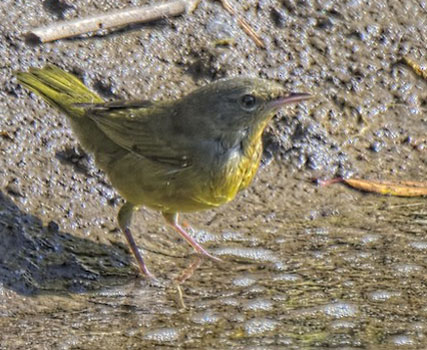
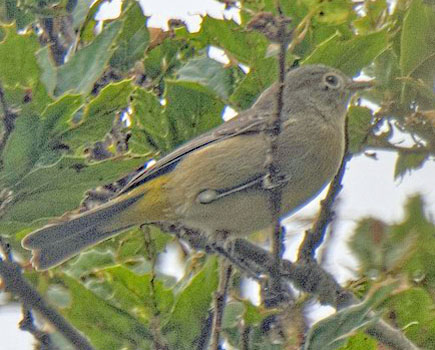
 Other September vagrant passerines included Eastern Kingbirds: one at Moonglow Dairy 12-15 Sep (Cooper Scollan et al.), and one in the restricted-access Odello area at Carmel R. mouth from 16-22 Sep (Karen Kreiger et al., photo right 16 Sep, © Karen Kreiger). Single Least Flycatchers were photographed at Moss Landing on 23 Sep (Kent Van Vuren) and at Carmel R. mouth on 24 Sep (Paul Fenwick, Brian Sullivan, Rita Carratello, Don Roberson).
Other September vagrant passerines included Eastern Kingbirds: one at Moonglow Dairy 12-15 Sep (Cooper Scollan et al.), and one in the restricted-access Odello area at Carmel R. mouth from 16-22 Sep (Karen Kreiger et al., photo right 16 Sep, © Karen Kreiger). Single Least Flycatchers were photographed at Moss Landing on 23 Sep (Kent Van Vuren) and at Carmel R. mouth on 24 Sep (Paul Fenwick, Brian Sullivan, Rita Carratello, Don Roberson).
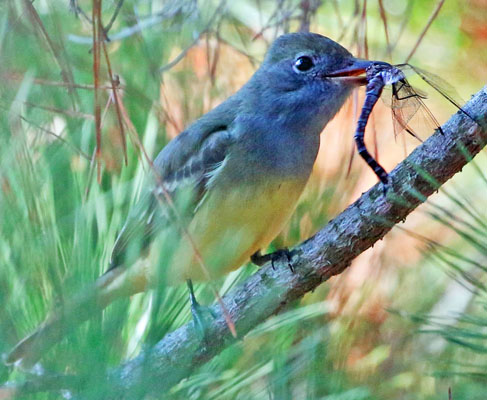
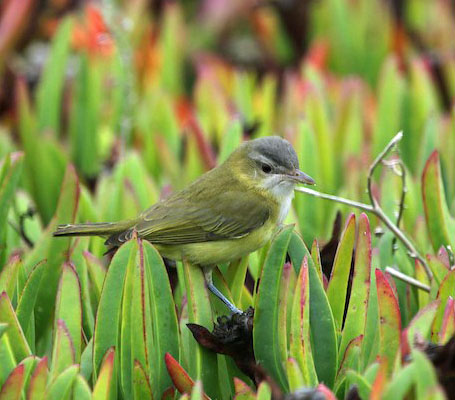
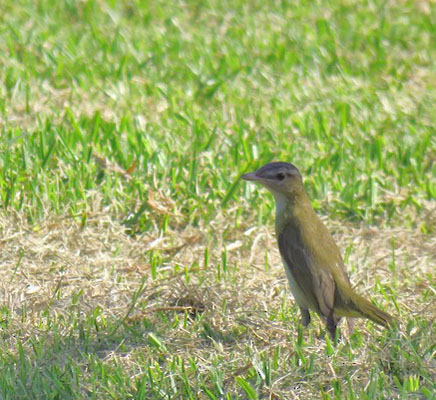
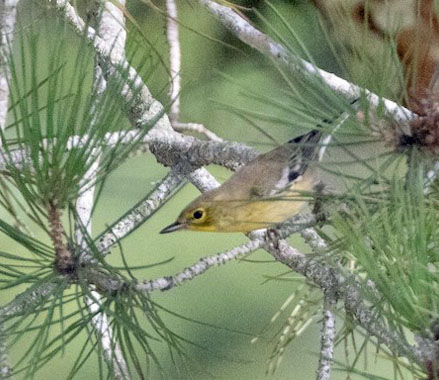
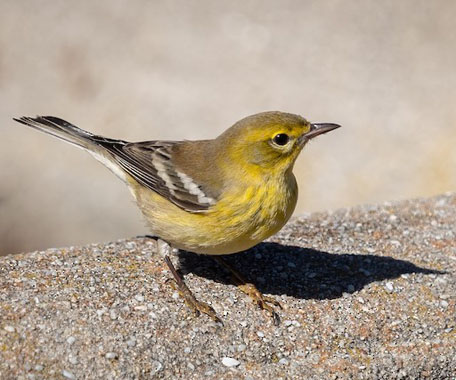
 During the week preceding Sullivan's piney find, El Estero cemeteries in Monterey were often tramped by birders, with more routine rarities seemingly found day after day. The eBird alert of a Clay-colored Sparrow caught the attention of a birder passing by, who stopped by to seek a county bird. What Gary Deghi found instead was an engaging hatch-year Dickcissel (photo right 13 Oct, © D. Roberson). It would remain in the same general area of grass and cement edgings for 11 days — from 13-23 October — and attract observers with cameras from far and near.
During the week preceding Sullivan's piney find, El Estero cemeteries in Monterey were often tramped by birders, with more routine rarities seemingly found day after day. The eBird alert of a Clay-colored Sparrow caught the attention of a birder passing by, who stopped by to seek a county bird. What Gary Deghi found instead was an engaging hatch-year Dickcissel (photo right 13 Oct, © D. Roberson). It would remain in the same general area of grass and cement edgings for 11 days — from 13-23 October — and attract observers with cameras from far and near.

